Overview
The article titled "7 Key Points on the DSM Autism Checklist for Parents" highlights crucial elements of the DSM autism checklist that every parent should know when evaluating their children for Autism Spectrum Disorder (ASD). It underscores the significance of understanding the DSM-5 criteria, which is vital for achieving accurate diagnoses and timely interventions. Such interventions can profoundly enhance developmental outcomes for children with autism.
As parents, navigating the complexities of autism can feel overwhelming. However, being informed about the DSM-5 criteria empowers you to make knowledgeable decisions that can positively impact your child's journey. By recognizing the signs early, you can seek the support and resources necessary for fostering your child's growth and development.
We encourage you to delve deeper into the DSM autism checklist and connect with professionals who can guide you through this process. Your proactive approach can make all the difference in your child's life, ensuring they receive the understanding and care they deserve.
Introduction
In a world where the complexities of Autism Spectrum Disorder (ASD) are increasingly recognized, the importance of informed support for families cannot be overstated. Understanding these intricacies—from the nuances of ABA therapy to the variations in symptom presentation based on gender—serves as a crucial foundation for empowering both parents and professionals.
This article invites you to explore a comprehensive array of resources and strategies aimed at enhancing awareness, facilitating early diagnosis, and promoting individualized support for children with autism. By delving into diagnostic tools, community support, and the latest research findings, we aim to equip you with the essential knowledge to navigate the challenges of autism effectively.
Together, we can ensure that every child has the opportunity to thrive in a nurturing and supportive environment.
About ASD Media: Empowering Parents with Autism Resources
ASD Media is dedicated to enhancing the implementation of ABA therapy by providing valuable insights and strategies that address challenges while improving outcomes. This organization offers a comprehensive range of resources tailored for both parents and professionals in the field. Their mission is to cultivate a nurturing and inclusive community where individuals can share experiences, learn from one another, and obtain crucial assistance throughout their journeys.
By signing up for their newsletter, members gain access to the latest news and unlimited digital resources, empowering them to unlock the potential of children with developmental disorders and ADHD. ASD Media equips parents and professionals with effective strategies for managing challenging behaviors, navigating assistance services, and enhancing social skills development.
Recent trends suggest that the duration of therapy is influenced by factors such as the severity of the condition and specific therapy goals. This underscores the necessity for tailored treatment plans. As highlighted by the Centers for Disease Control and Prevention (CDC), "The financial impact of this condition influences not just families but society overall, stressing the necessity for heightened awareness and assistance." For instance, a case study on improving sibling relationships through ABA techniques illustrated how these strategies foster understanding and empathy, ultimately enhancing family cohesion. This exemplifies the significance of community assistance in developing effective ABA therapy practices and demonstrates how ASD Media's resources can support families in navigating these challenges.
ASD Media's commitment to creating a knowledgeable community is evident in their mission to offer resources that empower caregivers and professionals alike. This ensures that they are well-prepared to assist individuals with developmental disorders and ADHD effectively.
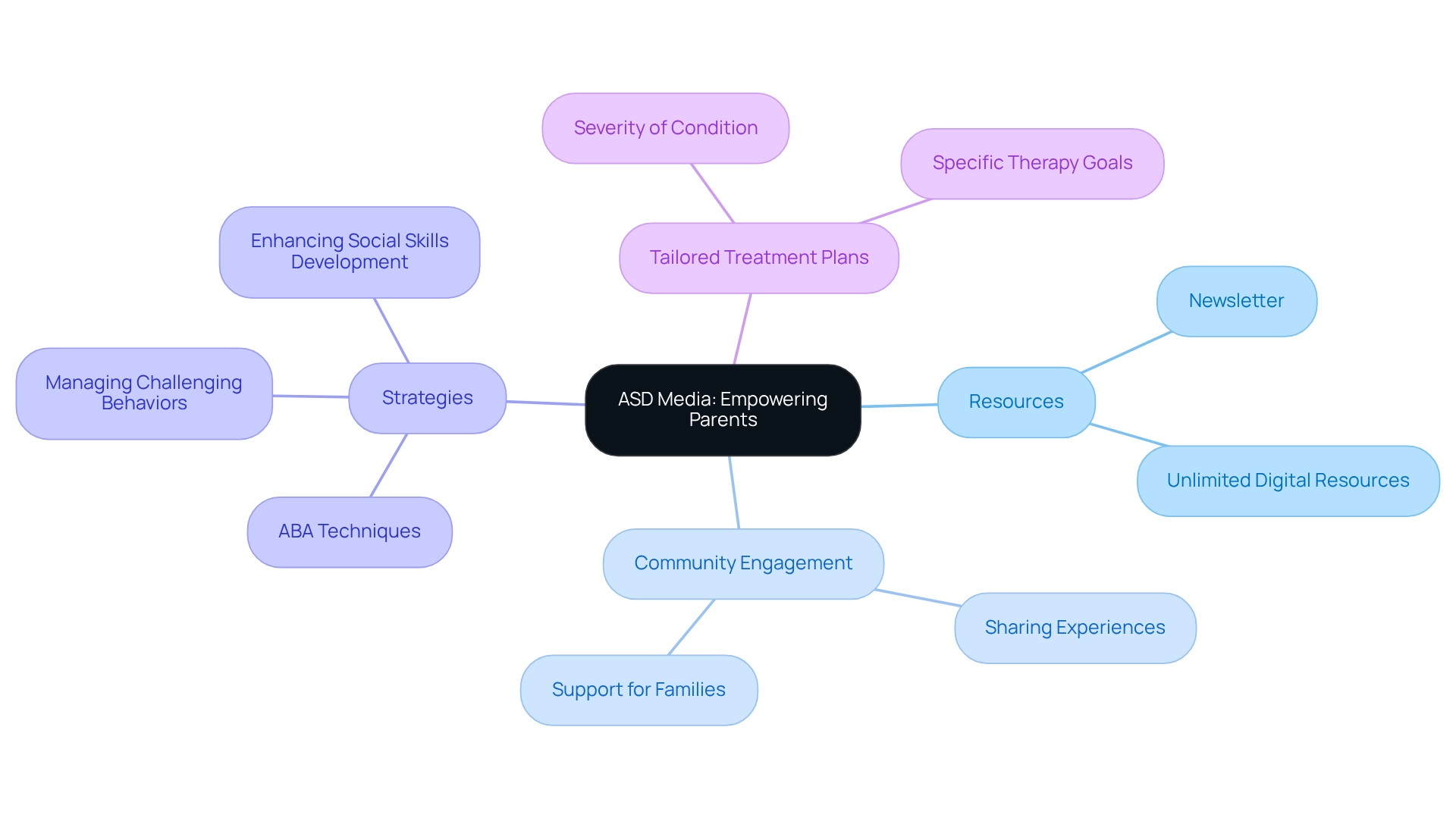
DSM-5 Criteria: Key Standards for Autism Diagnosis
The DSM-5 establishes clear criteria for diagnosing Autism Spectrum Disorder (ASD), which can be evaluated using the dsm autism checklist, emphasizing the importance of persistent deficits in social communication and interaction across various contexts, along with restricted and repetitive patterns of behavior. For caregivers, understanding these standards is vital as it enables them to recognize potential signs of developmental disorders in their children, paving the way for timely intervention and support.
Recognizing the role of behavior is essential for driving meaningful change within these diagnostic standards. It empowers caregivers and specialists to tailor interventions that meet the unique needs of each individual. Moreover, real-world examples illustrate how parents have successfully identified signs of the disorder using the dsm autism checklist, leading to improved outcomes for their children.
Experts in the field emphasize that a deep understanding of these criteria not only assists in accurate diagnosis but also nurtures a supportive environment for individuals with autism, allowing them to flourish and achieve their full potential. As Haley Moss poignantly expresses, 'I might hit developmental and societal milestones in a different order than my peers, but I am able to accomplish these small victories on my own time.' This perspective underscores the importance of recognizing and supporting each young person's unique journey.
Additionally, inspiring quotes from autistic individuals highlight the resilience and strength of those on the spectrum, reinforcing the critical nature of early identification and intervention. Together, we can foster an environment where every child is celebrated for their unique path, and where caregivers feel equipped to provide the support their children need to thrive.
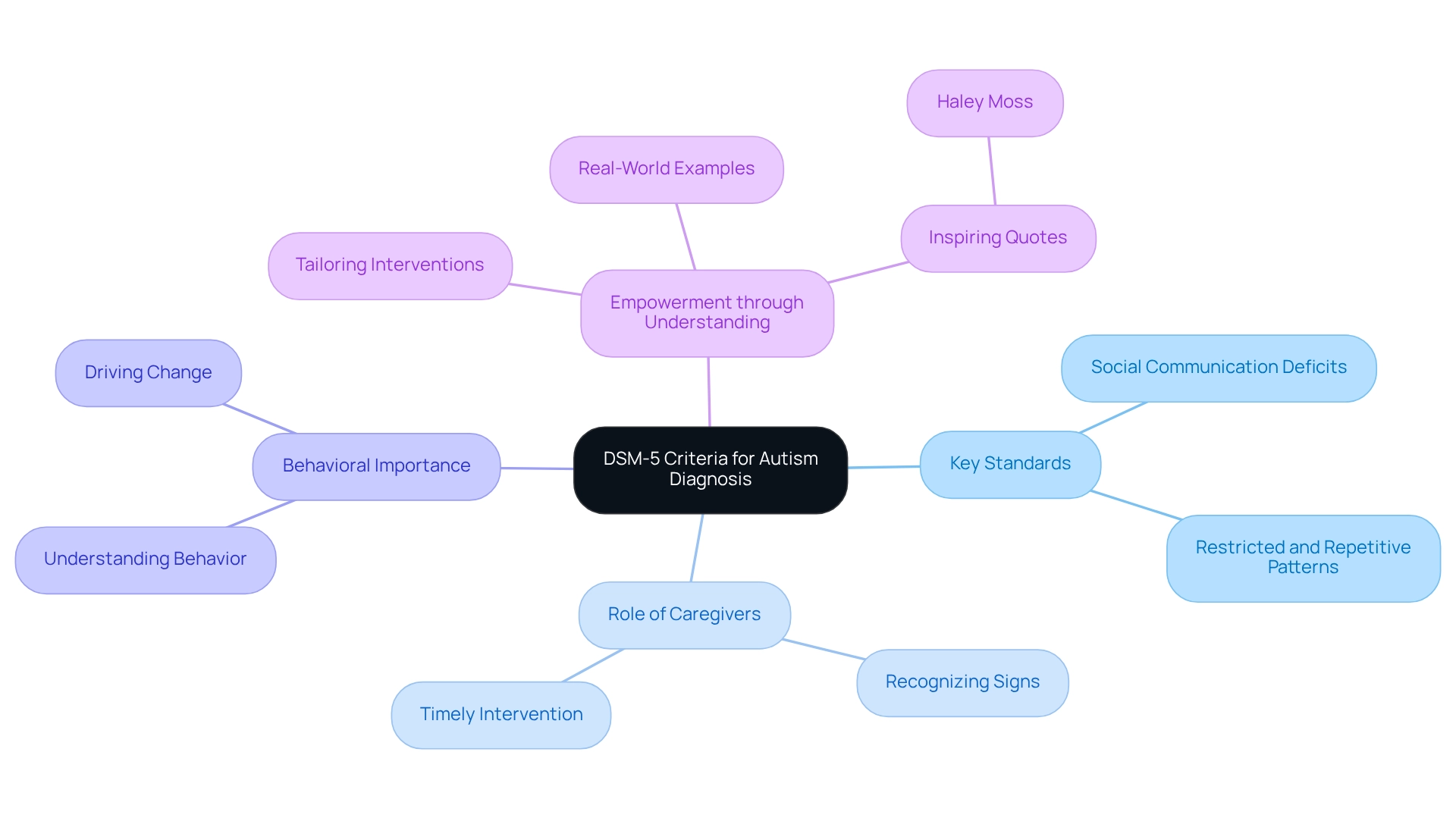
M-CHAT: A Screening Tool for Early Autism Detection
The Modified Checklist for Autism in Toddlers (M-CHAT) serves as a vital parent-report screening tool, designed to help identify children at risk for Autism Spectrum Disorder (ASD) between the ages of 16 and 30 months. With 20 targeted questions, the M-CHAT assesses specific behaviors associated with autism, enabling early detection that can change lives. Research indicates that children evaluated with the M-CHAT receive a diagnosis more than a year earlier than the current median age of diagnosis in the United States, averaging just 25 months. This early identification is crucial, as timely interventions can greatly improve developmental outcomes.
The effectiveness of the M-CHAT is highlighted by its sensitivity and specificity coefficients; a score of 6 or higher signals a high risk for ASD, while lower scores suggest a reduced risk. This classification standard, established through thorough studies, provides clear guidelines for further diagnostic evaluation. Pediatricians emphasize the importance of early screening tools like the M-CHAT, noting that they can lead to effective early interventions, ultimately enhancing the quality of life for children and their families. Moreover, advancements in neuroimaging techniques hold promise for improving early detection and intervention strategies, reinforcing the value of tools such as the M-CHAT.
Beyond its statistical effectiveness, heartwarming success stories from families who have used the M-CHAT for early intervention showcase the tool's practical impact. These narratives illustrate how early identification can lead to prompt assistance and better outcomes for children with developmental challenges. As the field continues to evolve, the M-CHAT stands as a cornerstone in the landscape of early detection and intervention for developmental disorders, inviting parents to take proactive steps for their children's futures.
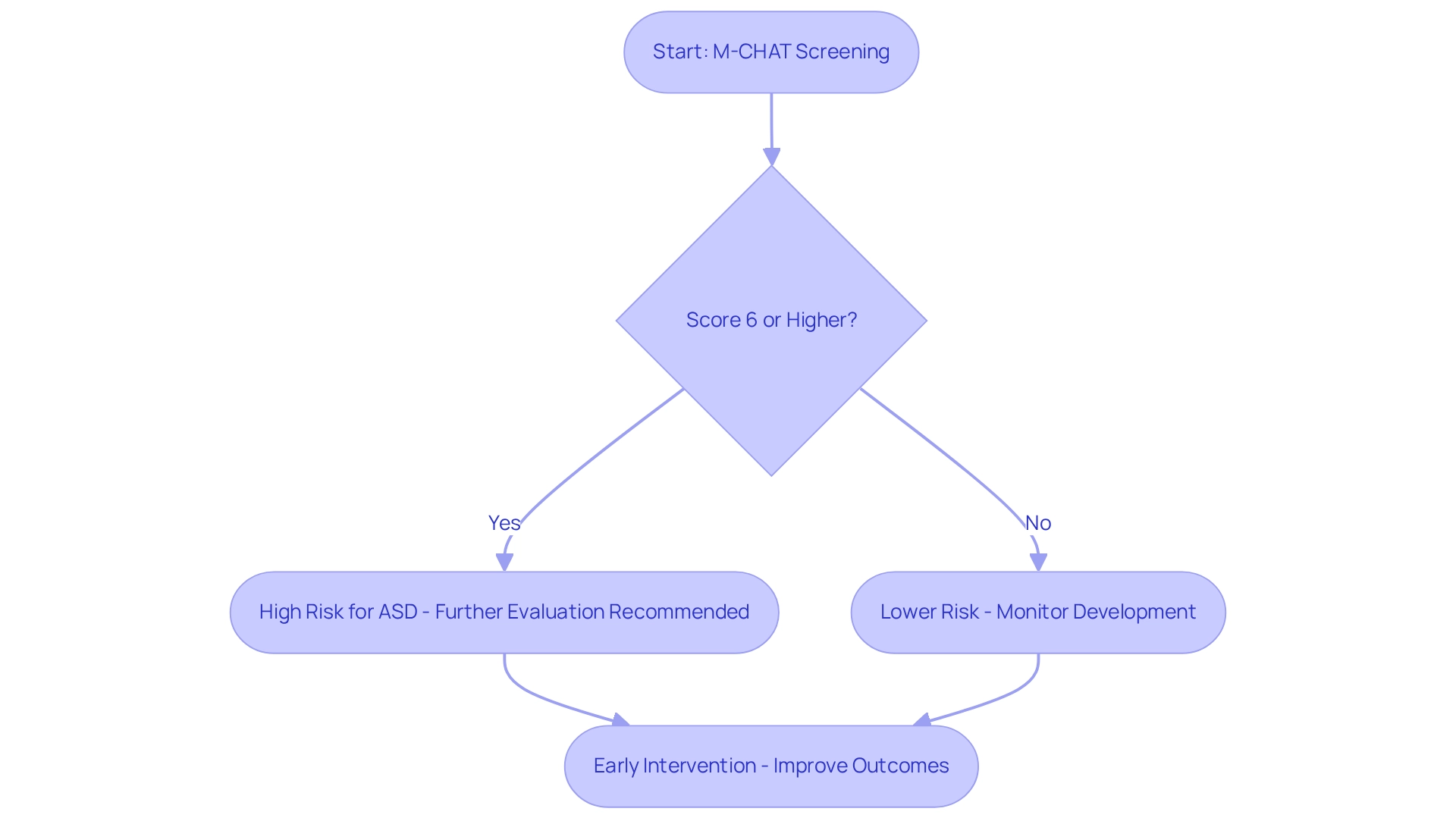
Gender Differences: Recognizing Unique Autism Symptoms
Research consistently shows that autism is diagnosed more frequently in males than in females, a disparity often attributed to differences in symptom presentation. Females tend to exhibit subtler symptoms and are more adept at camouflaging their behaviors, which can lead to significant underdiagnosis. A recent study highlights the importance of prompt diagnosis in enhancing well-being and access to assistance, especially for autistic girls. Early detection can prevent the intensification of issues during adolescence, fostering improved self-awareness and acceptance.
Recognizing these gender disparities is crucial for caregivers and specialists. It ensures that all children, regardless of gender, receive appropriate assessments and support tailored to their individual needs. Experts emphasize that symptoms can differ between males and females, with current research suggesting that females may exhibit distinct behavioral patterns that are often overlooked. To better recognize these differences, parents and professionals should consider seeking evaluations from specialists trained to identify the subtler signs of autism in girls. This proactive approach can lead to more accurate diagnoses and enhanced support for every young person.
In summary, acknowledging these gender differences is essential for cultivating an inclusive environment where all individuals can thrive and receive the help they need. By sharing experiences and seeking the right resources, we can create a supportive community that embraces every child's unique journey.
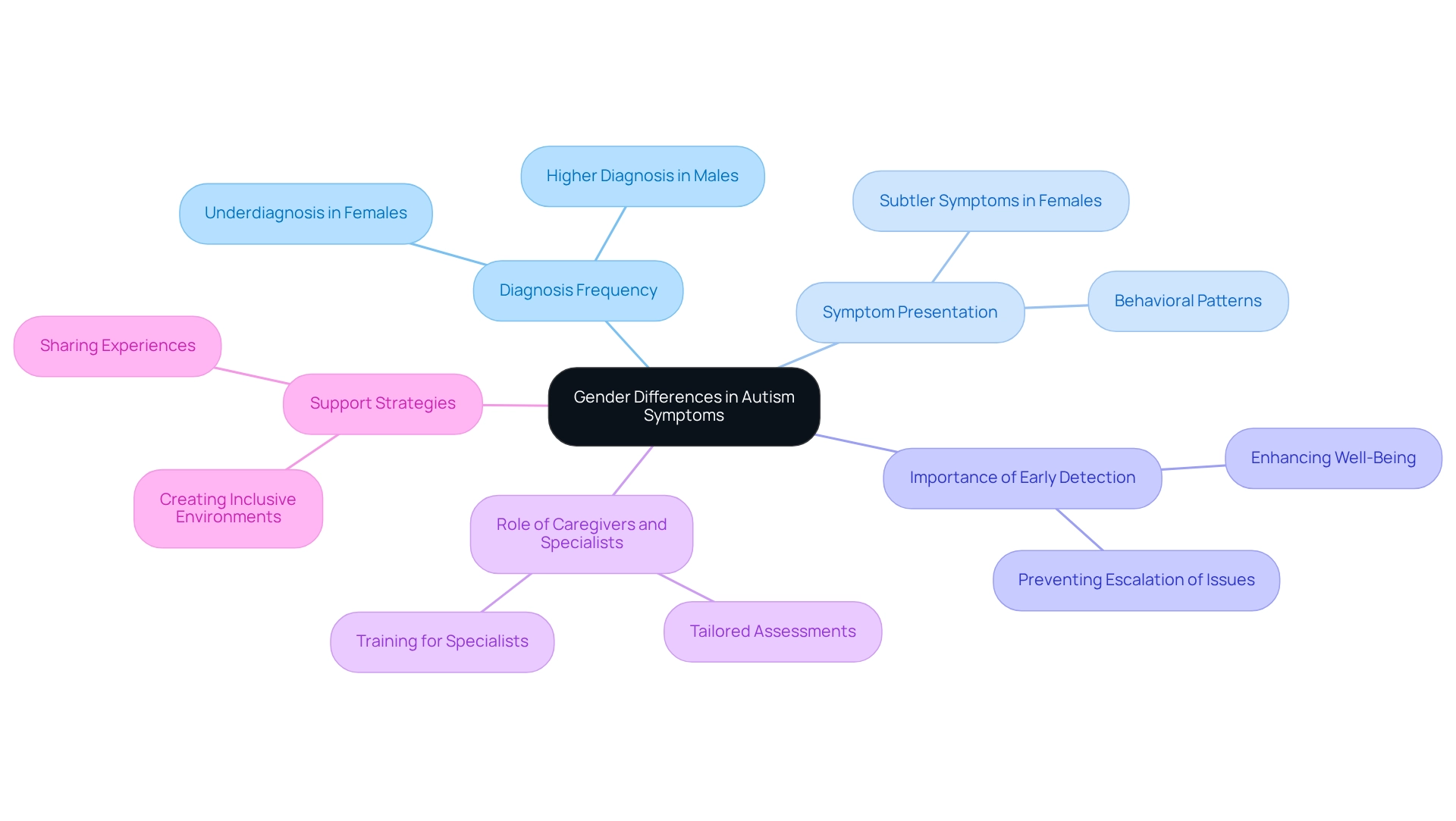
Early Diagnosis: Importance for Effective Intervention
Recognizing autism in a timely manner is essential for effective intervention. Studies reveal that individuals diagnosed before the age of 2.5 years show remarkable improvements in developmental outcomes compared to those diagnosed later. Early assistance offers children vital resources and support, significantly enhancing their ability to thrive.
For instance, research shows that introducing augmentative and alternative communication strategies as early as 12 months can lead to better communication skills in young individuals facing challenges. Additionally, the financial benefits of early intervention are substantial; it's estimated that such measures can save approximately $1.3 million per person over their lifetime by reducing the need for long-term special education and intensive care.
This underscores the importance of parents seeking assessments promptly when concerns arise. Timely identification can lead to more effective strategies for managing behaviors and fostering social interaction, which are crucial for the development of young individuals with developmental disorders.
As Sarah Webster, a BCBA, highlights, "Educating others on what the condition is and creating a more accepting and compassionate environment is essential for the growth of our children."
Parents are encouraged to subscribe to ASD Media's newsletter to stay informed about the latest news and gain unlimited digital access to valuable resources that support their journey.
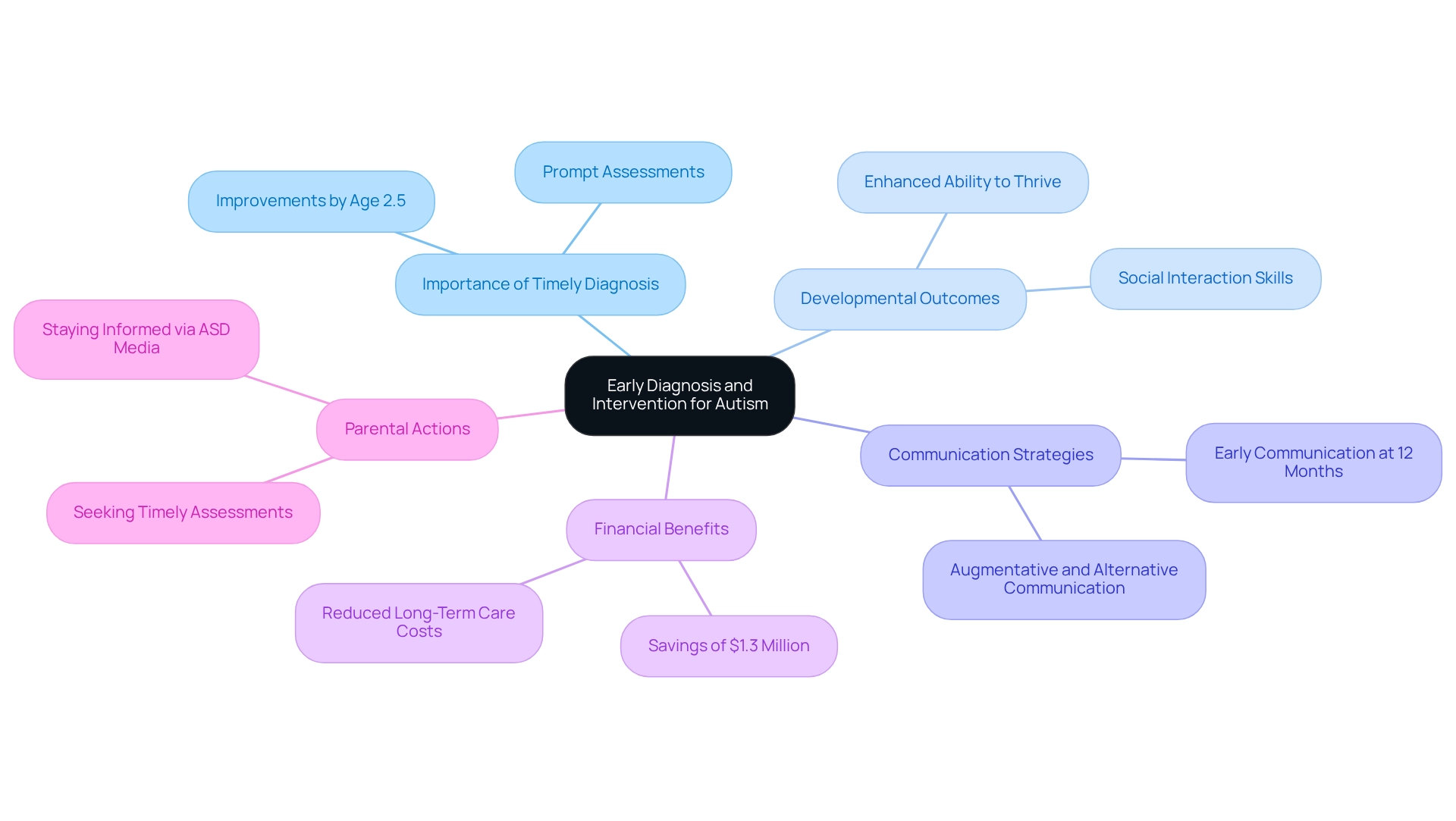
Diagnostic Tools: Methods for Assessing Autism
A range of diagnostic tools is essential for evaluating developmental disorders, with the Autism Diagnostic Observation Schedule (ADOS) and the Autism Diagnostic Interview-Revised (ADI-R) among the most commonly used. These structured assessments empower clinicians to evaluate critical aspects of a child's behavior and communication skills, offering a comprehensive understanding of their developmental profile. According to the ICD-11, the onset of spectrum disorder typically occurs during early childhood, highlighting the importance of early diagnosis. Recent studies indicate that the effectiveness rates of these tools remain high, with the ADOS and ADI-R being integral to the diagnostic process in 2025.
For instance, a survey conducted among autistic adults in New Zealand revealed valuable insights into the diagnostic process, shedding light on both obstacles and supports that can guide improvements in services for individuals on the spectrum. This aligns with Sarrett's research on the barriers to formal diagnosis of spectrum disorder in adults, underscoring the ongoing challenges within the diagnostic journey. Additionally, expert opinions emphasize the significance of these tools in accurately diagnosing the condition, as they provide a standardized method that enhances the reliability of evaluations.
Temple Grandin once observed, 'What would occur if the gene linked to autism were removed from the gene pool? You would have a bunch of people standing around in a cave, chatting and socializing and not getting anything done.' This poignant quote underscores the importance of neurodiversity and the necessity of understanding conditions beyond mere diagnosis.
Parents who familiarize themselves with the ADOS and ADI-R can navigate the complexities of the diagnostic process more effectively. Utilizing these tools not only empowers caregivers but also fosters collaboration with healthcare providers, ultimately leading to more successful outcomes for children. Insights from Jashar et al. (2019) regarding caregiver perceptions of diagnostic evaluations for toddlers at risk for developmental disorders further highlight the need for guardians to be informed and engaged. As the landscape of developmental disorder evaluation evolves, staying knowledgeable about updates and best practices in using these diagnostic instruments is crucial for parents supporting their children.
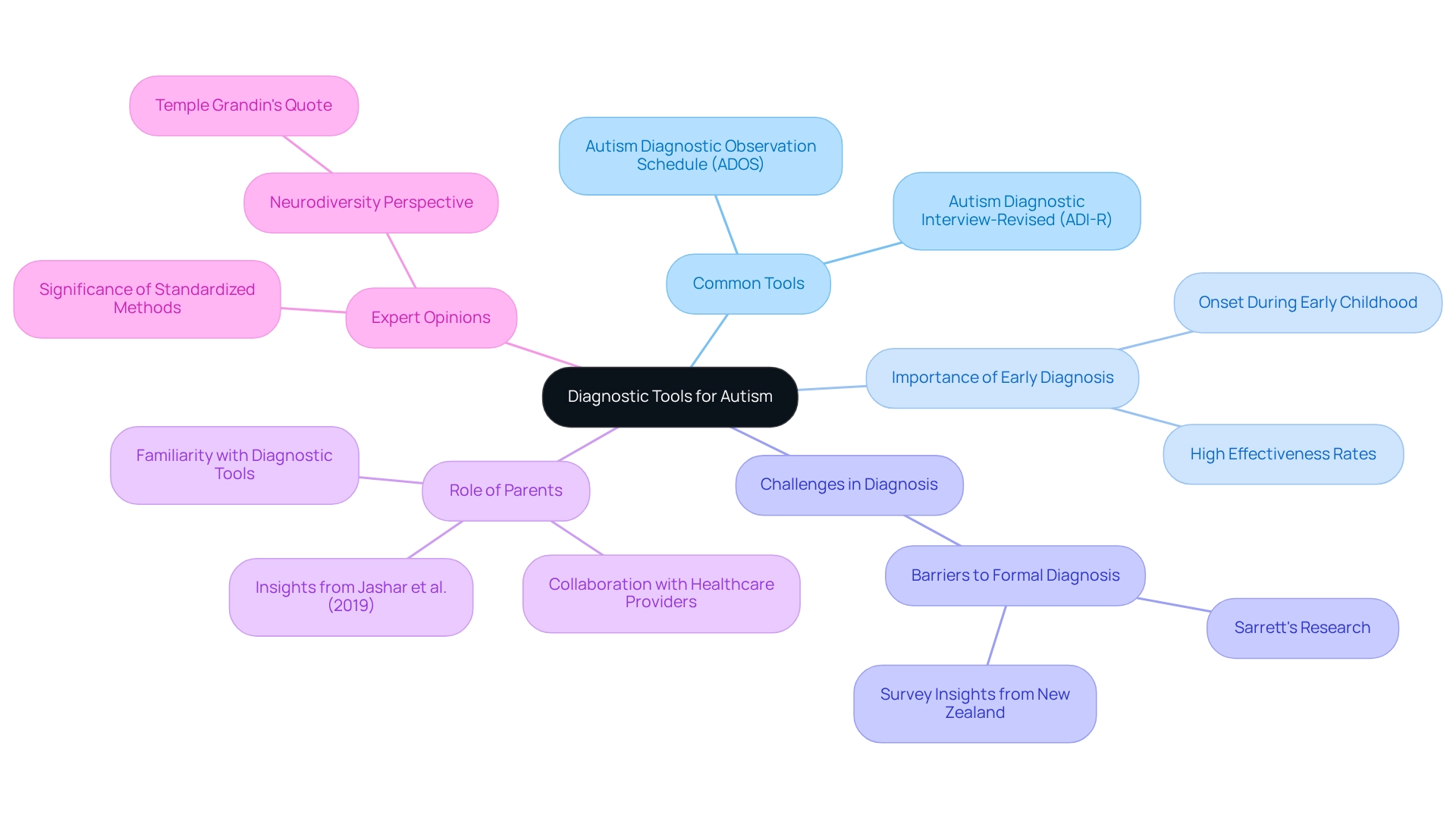
Impact of DSM-5 Revisions: Understanding Changes in Diagnosis
The recent revisions in the DSM-5 have brought together previously distinct categories of autism into one unified diagnosis known as Autism Spectrum Disorder (ASD). This change aims to improve diagnostic clarity, but it may also impact eligibility for various services. Experts in the field have observed that while these adjustments offer a more streamlined approach, they might have a lesser effect on service eligibility compared to their influence on prevalence estimates. As Matthew J. Maenner, PhD, insightfully noted, "This suggests that the ASD criteria could have a smaller effect on eligibility for services than their effect on prevalence estimates."
Looking ahead to 2025, current eligibility rates for developmental services reflect these changes. Many caregivers are adapting to the new standards by seeking additional resources and support. A recent comparative effectiveness report pointed out that there are few studies adequately evaluating treatment options for adolescents and young adults with ASD, underscoring the pressing need for high-quality research in this area. For instance, guardians are increasingly turning to online forums and local support groups to exchange experiences and strategies for navigating this new diagnostic landscape.
Case studies indicate that the rising prevalence rates of ASD are primarily due to evolving diagnostic practices and increased awareness, rather than an actual surge in cases. This shift has promoted greater societal acceptance and inclusion of neurodiversity in various settings, such as homes, schools, and workplaces. Understanding these changes is crucial for parents as they navigate the complexities of diagnosis and support, ensuring they are well-equipped to advocate for their children in an ever-evolving environment.
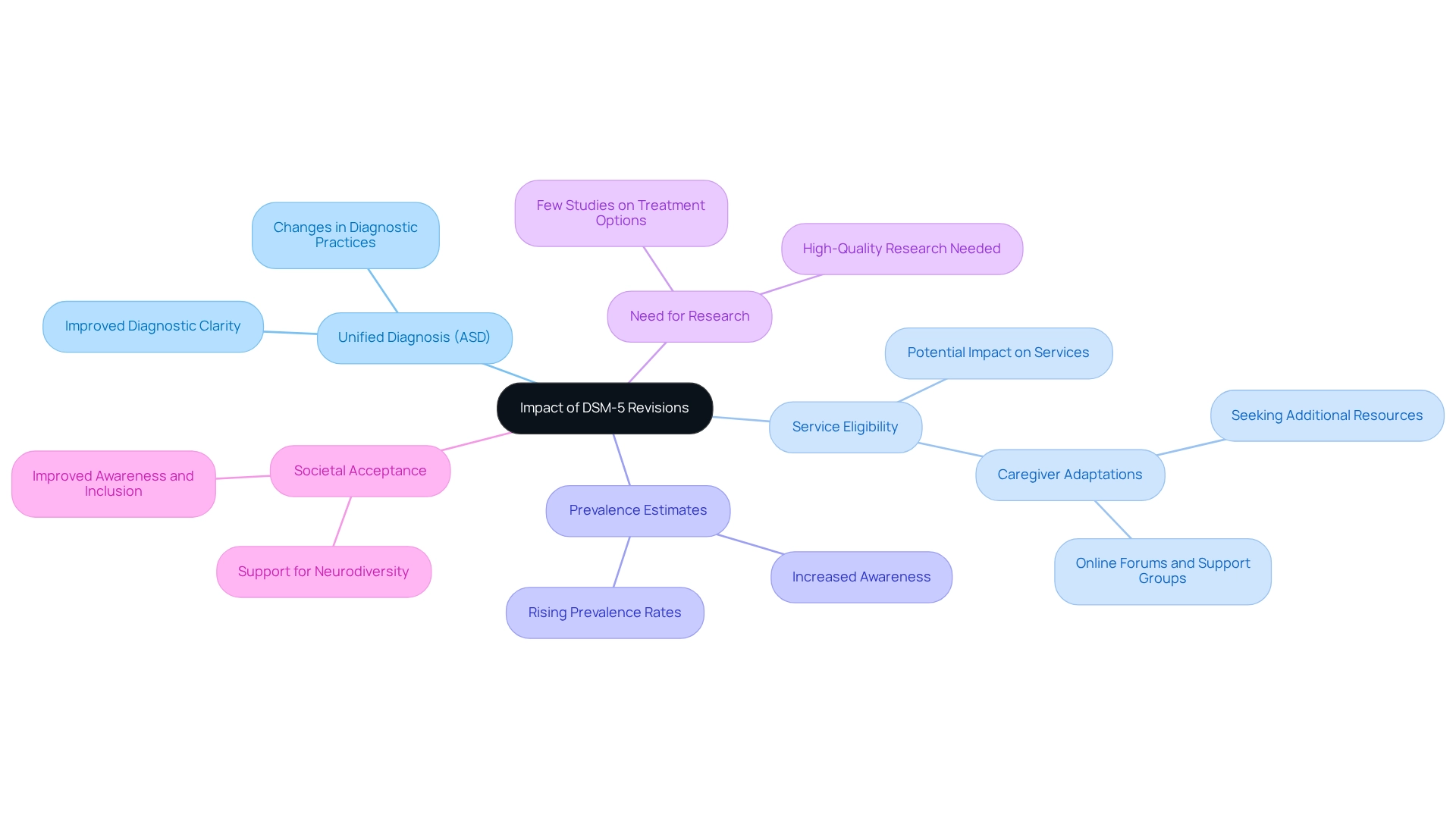
Individualized Support: Tailoring Strategies for Autism
Personalized assistance is vital for individuals with autism, recognizing that each person possesses unique strengths and challenges. By tailoring strategies to meet these specific needs, we can significantly enhance the effectiveness of interventions. This approach encompasses:
- Personalized education plans
- Behavioral strategies
- Therapeutic methods that resonate with the individual's interests and abilities
For instance, customized education plans have been shown to boost engagement and learning outcomes. Research indicates that young learners receiving tailored interventions demonstrate greater progress in social skills and academic performance. Furthermore, case studies, such as those from Rainbow ABA, illustrate how tailored therapy solutions empower children to thrive by focusing on their individual needs, with results revealing substantial improvements in both behavioral and academic areas.
Educators highlight that adapting interventions to fit individual profiles not only cultivates a supportive learning environment but also nurtures emotional well-being. Caregivers of individuals with PDA often face significant distress and fatigue while managing demands and seeking support, making the necessity for tailored strategies even more critical. The saying, 'Being kind is never wasted,' resonates deeply in this context, underscoring the importance of compassion in supporting young individuals with developmental disorders.
As the landscape of neurodevelopmental assistance evolves in 2025, our commitment to personalized approaches remains a cornerstone of effective practice, ensuring that every young person has the opportunity to realize their full potential.
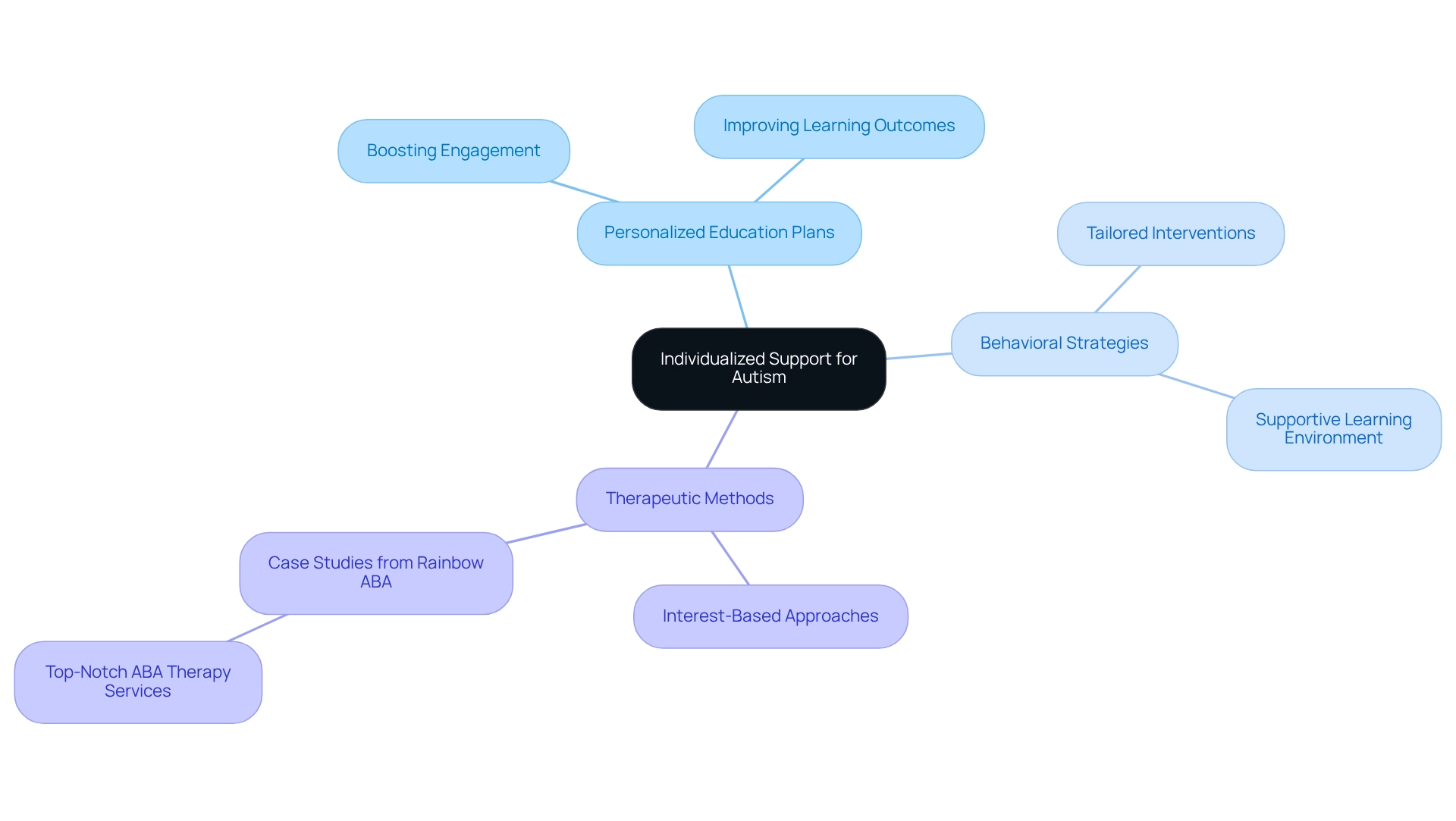
ABA Therapy: Effective Intervention for Autism
Applied Behavior Analysis (ABA) therapy is a beacon of hope for individuals with autism, focusing on enhancing specific behaviors, communication skills, and social interactions. Research consistently highlights the transformative impact of ABA therapy, making it an invaluable resource for parents seeking effective support for their children. For instance, recent findings reveal that young individuals engaged in ABA therapy show remarkable improvements in communication and social skills—essential components for their overall development.
Moreover, statistics reveal that a significant number of children referred for ABA therapy experience positive outcomes. In fact, 23% of youths are referred without needing subsequent services, underscoring the critical importance of these vital interventions. As we continue to explore this field, ongoing research reaffirms the benefits of ABA, highlighting the necessity of personalized treatment plans that cater to the unique needs of each child.
Ralph Moller wisely states, "By concentrating on the particular needs of the person with the condition, rather than merely the diagnostic label, therapy can be modified to meet the individual's specific objectives and encourage advancement." This tailored approach not only fosters personal growth but also aligns with the broader goal of empowering families and professionals to navigate the complexities of care.
Looking ahead, future research should consider incorporating school records and socioeconomic factors to deepen our understanding of ABA therapy's impact. It's also essential to recognize that the duration of ABA therapy varies based on individual needs; many children benefit from 12 months of therapy, while fewer continue for 24 months. This variation highlights the importance of continuous evaluation and customized treatment strategies, ensuring that every child receives the support they truly need.
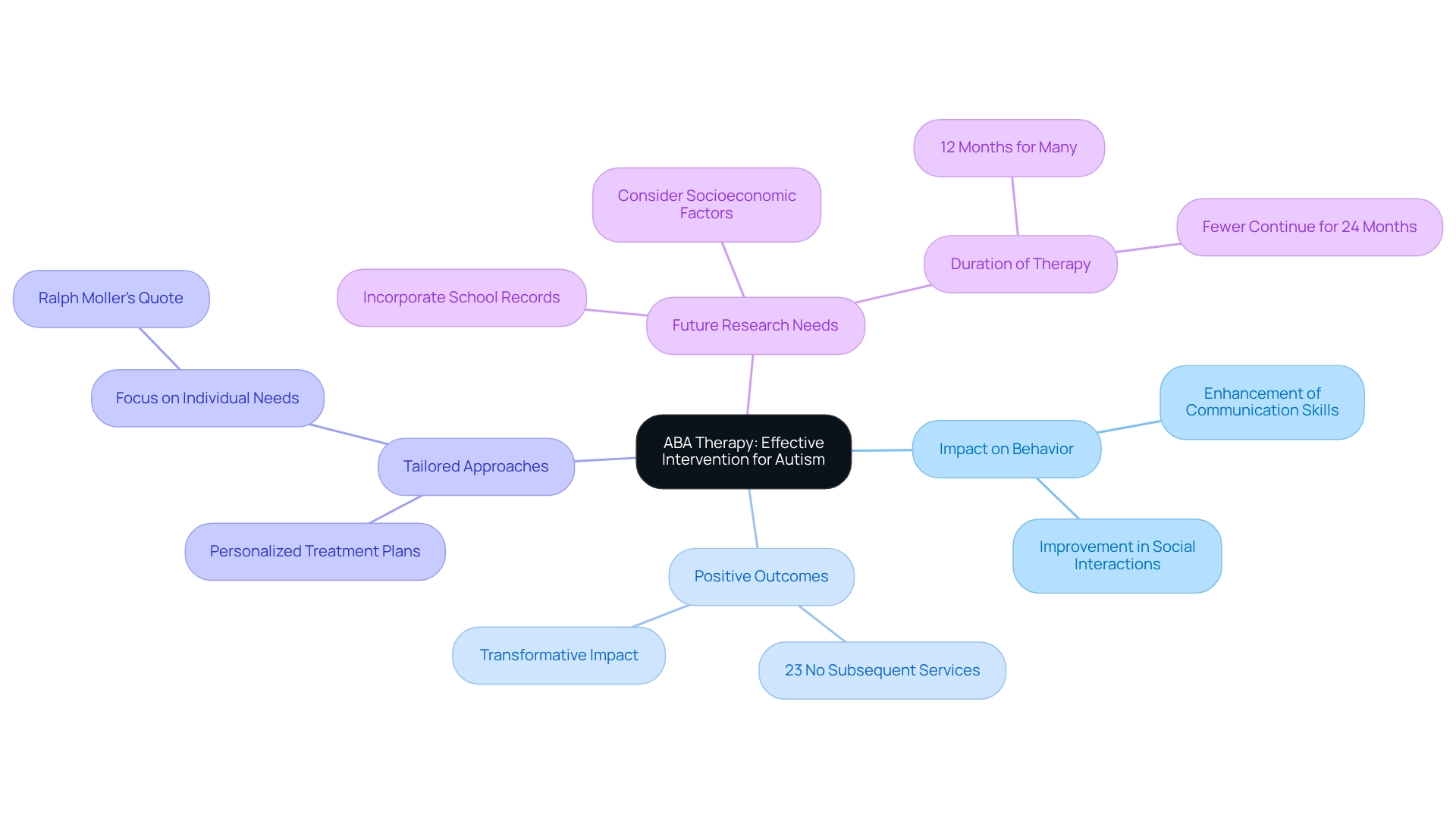
Community Support: Building Connections for Parents of Children with Autism
Community assistance is vital for caregivers of children with developmental disorders, offering emotional support, practical guidance, and a sense of belonging. Connecting with other parents through support groups, online forums, and local organizations fosters a collaborative environment that nurtures growth and understanding. Did you know that 36.5% of autism caregivers utilize ABA therapy? This statistic highlights how shared experiences can help navigate therapeutic options within these community settings.
Moreover, a recent study shows that ASD prevalence is notably higher among Hispanic and non-Hispanic Black children, revealing the pressing need for tailored community resources that cater to diverse backgrounds and experiences. Successful caregiver networks exemplify this necessity, providing platforms for advocacy and connection. As autism advocate Dr. Stephen Shore, who has autism himself, wisely states, "If you’ve met one person with autism, you’ve met one person with autism." This underscores the unique journey each family embarks on.
The benefits of these groups extend beyond emotional support; they empower caregivers to advocate effectively for their children, ensuring that educational plans, like IEPs, are customized to meet individual needs. With 73.6% of autistic students graduating high school, the role of community assistance in enhancing educational outcomes is crucial. By engaging with fellow caregivers, individuals can share strategies, celebrate successes, and collectively tackle challenges.
To begin this journey, parents can search for local support groups through community centers or online platforms. This reinforces the importance of community in the autism advocacy landscape, encouraging connection and shared experiences among families.
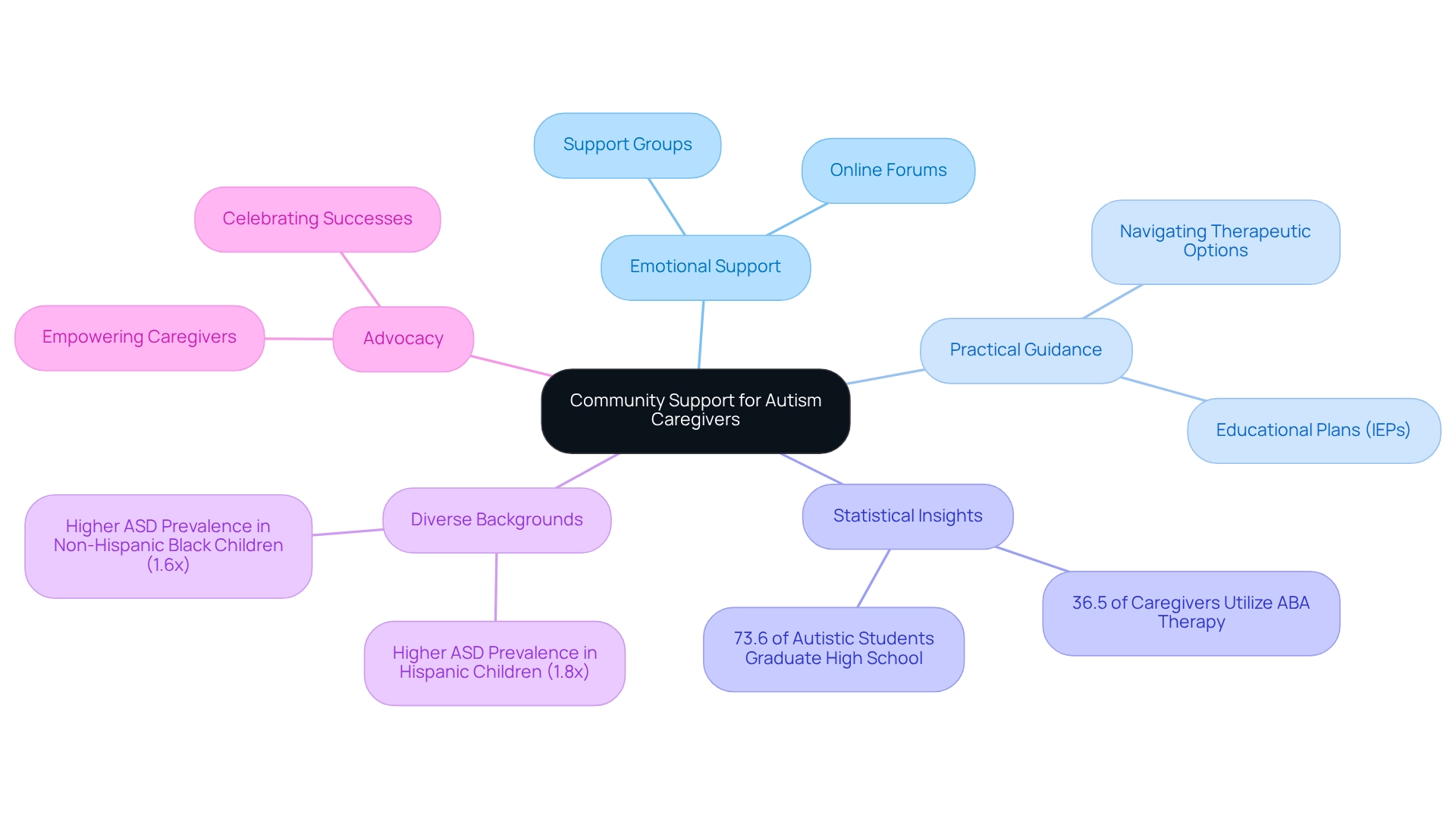
Conclusion
Supporting children with Autism Spectrum Disorder (ASD) is a journey that requires a multifaceted approach—one that embraces early diagnosis, individualized support, and community resources. Tools like the M-CHAT play a crucial role in early detection, enabling timely interventions that can significantly enhance developmental outcomes. It’s also vital to recognize the gender differences in autism presentation, ensuring all children receive appropriate evaluations and support tailored to their unique needs.
Consider the effectiveness of ABA therapy as an intervention. It underscores the importance of creating personalized treatment plans that cater specifically to each child’s requirements. By fostering a supportive environment through community connections, parents can share valuable experiences and strategies, empowering them to advocate effectively for their children. This collaborative effort not only nurtures individual growth but also cultivates a sense of belonging within the autism community.
Ultimately, the journey of supporting a child with autism flourishes with knowledge, awareness, and connection. By utilizing available resources and understanding the complexities of autism, families can navigate challenges with greater ease. Together, we can ensure that every child has the opportunity to thrive in a nurturing and inclusive environment.
Frequently Asked Questions
What is the mission of ASD Media?
ASD Media is dedicated to enhancing the implementation of ABA therapy by providing insights and strategies that address challenges while improving outcomes. Their mission is to cultivate a nurturing and inclusive community for individuals to share experiences, learn, and obtain assistance.
What resources does ASD Media offer to parents and professionals?
ASD Media offers a comprehensive range of resources tailored for both parents and professionals, including strategies for managing challenging behaviors, navigating assistance services, and enhancing social skills development. Members can also access the latest news and unlimited digital resources by signing up for their newsletter.
How does the duration of therapy relate to Autism Spectrum Disorder (ASD)?
Recent trends suggest that the duration of therapy is influenced by factors such as the severity of the condition and specific therapy goals, highlighting the necessity for tailored treatment plans.
Why is understanding the DSM-5 criteria important for caregivers?
Understanding the DSM-5 criteria is vital for caregivers as it enables them to recognize potential signs of developmental disorders in their children, paving the way for timely intervention and support.
What is the Modified Checklist for Autism in Toddlers (M-CHAT)?
The M-CHAT is a parent-report screening tool designed to identify children at risk for Autism Spectrum Disorder (ASD) between the ages of 16 and 30 months, using 20 targeted questions to assess specific behaviors associated with autism.
How does the M-CHAT contribute to early detection and intervention?
Research indicates that children evaluated with the M-CHAT receive a diagnosis more than a year earlier than the current median age of diagnosis in the United States. Early identification through the M-CHAT can lead to timely interventions that greatly improve developmental outcomes.
What do pediatricians say about early screening tools like the M-CHAT?
Pediatricians emphasize the importance of early screening tools like the M-CHAT, noting that they can lead to effective early interventions, ultimately enhancing the quality of life for children and their families.
What impact do success stories have regarding the M-CHAT?
Success stories from families who have used the M-CHAT for early intervention showcase the tool's practical impact, illustrating how early identification can lead to prompt assistance and better outcomes for children with developmental challenges.




